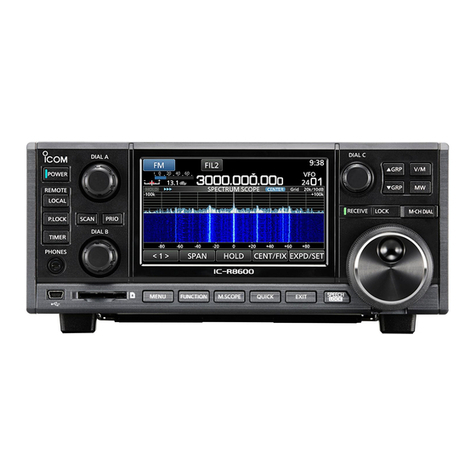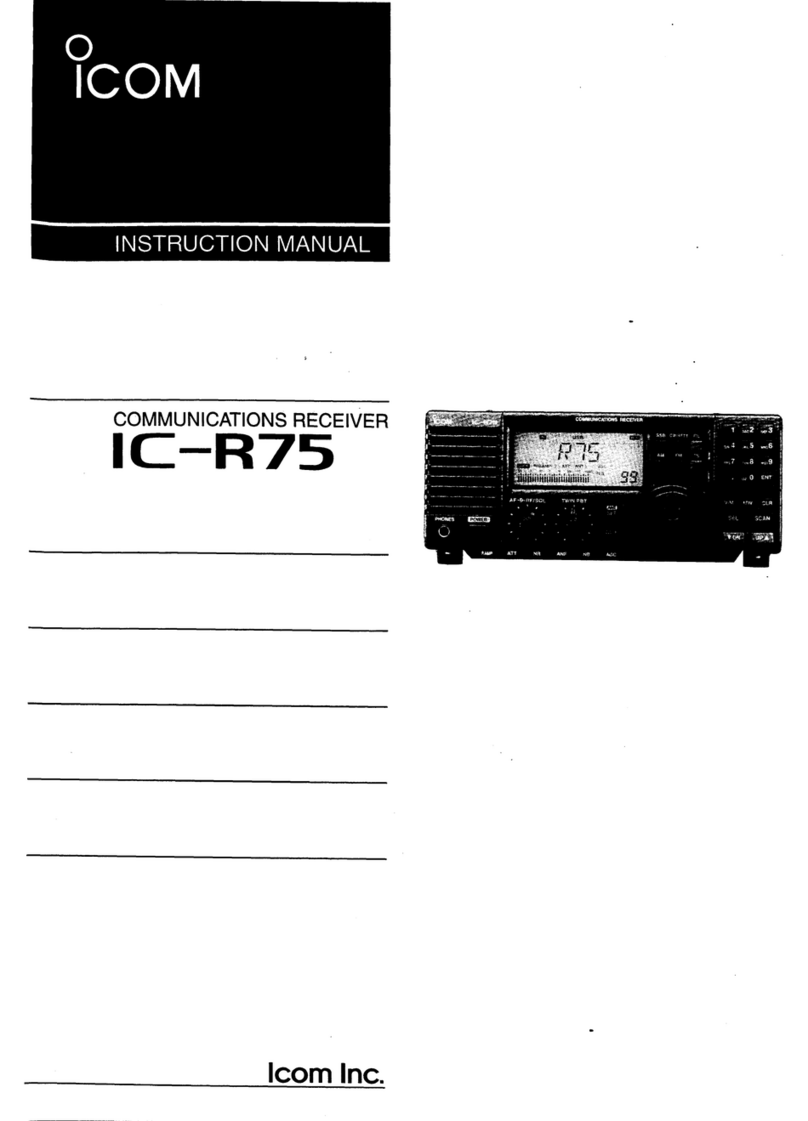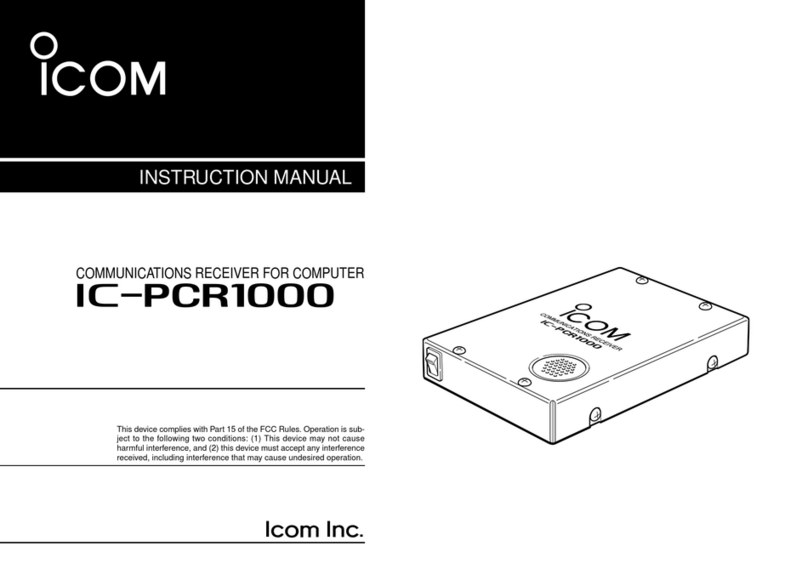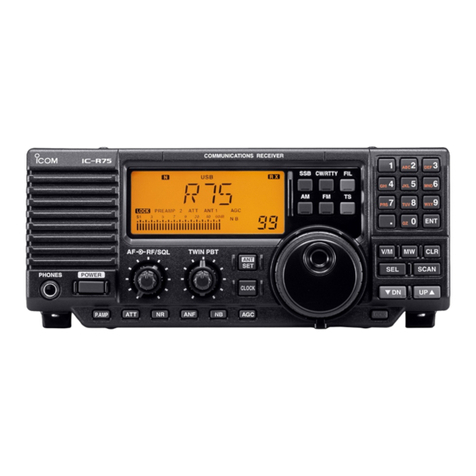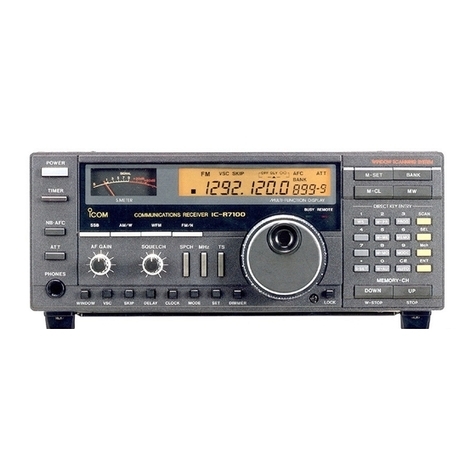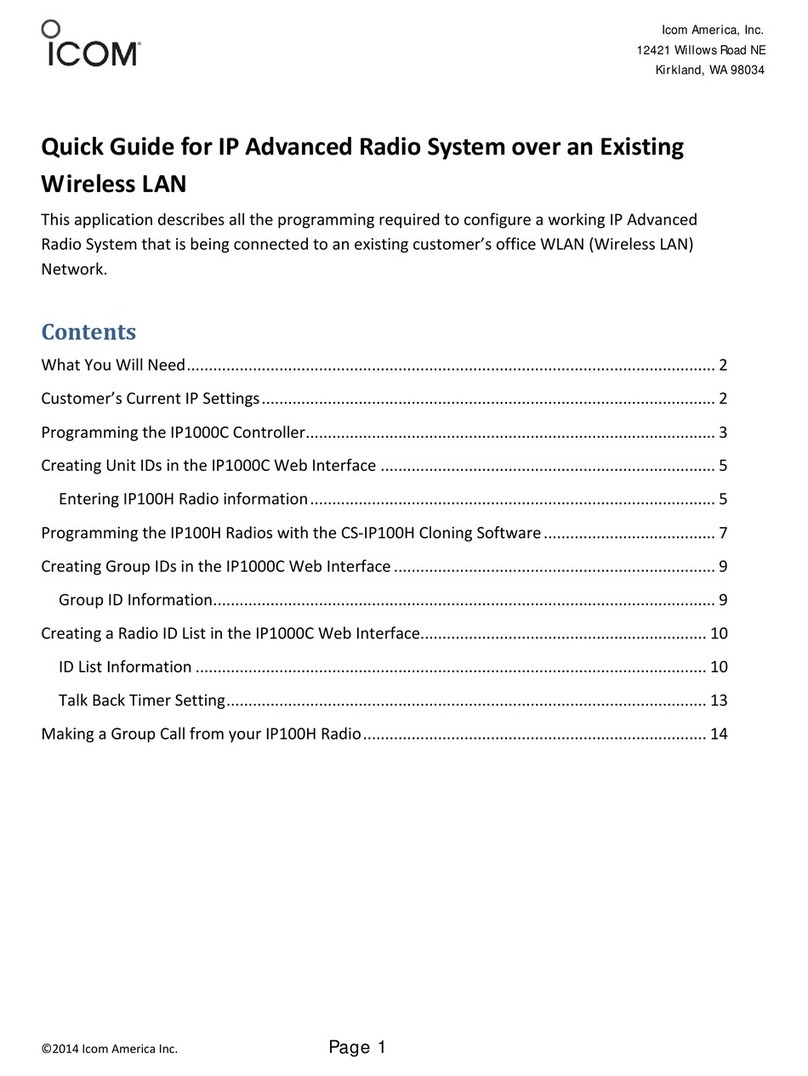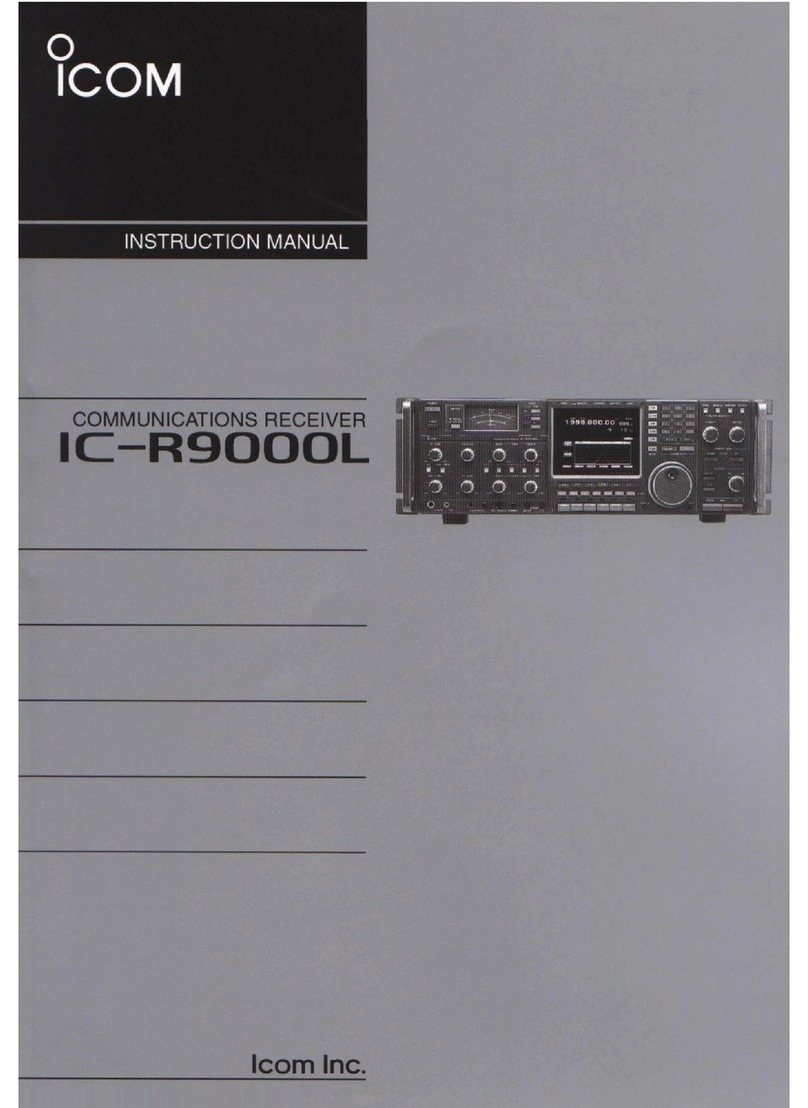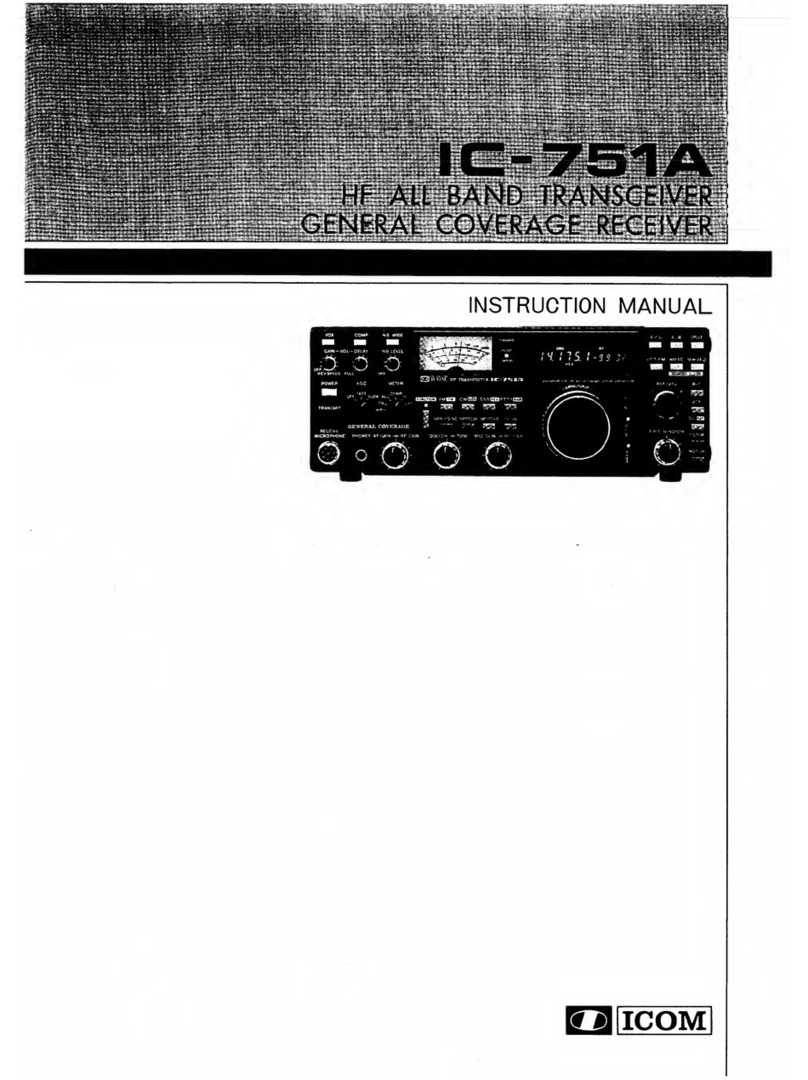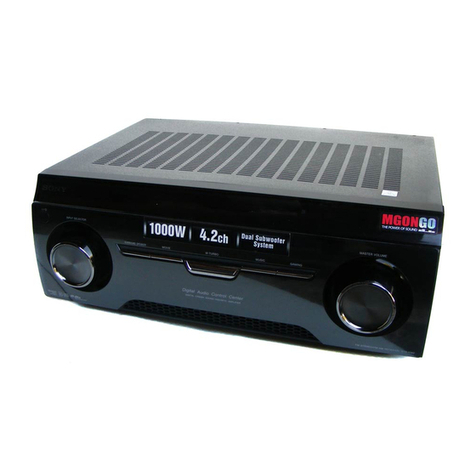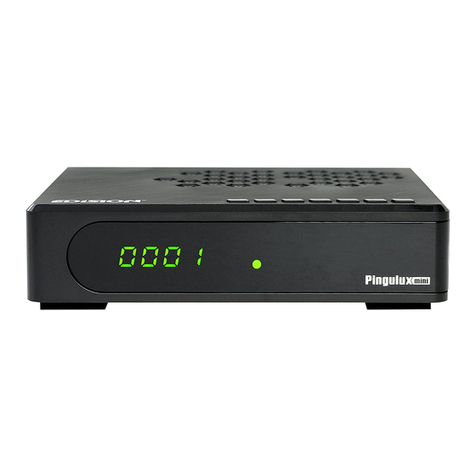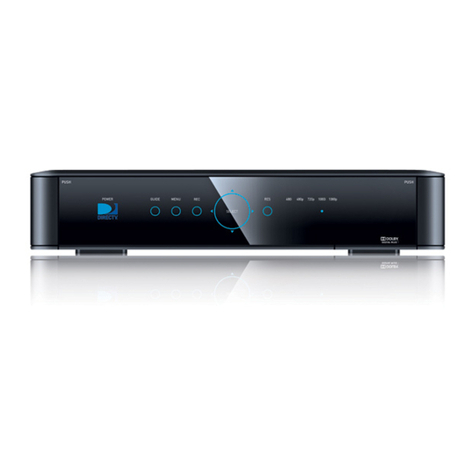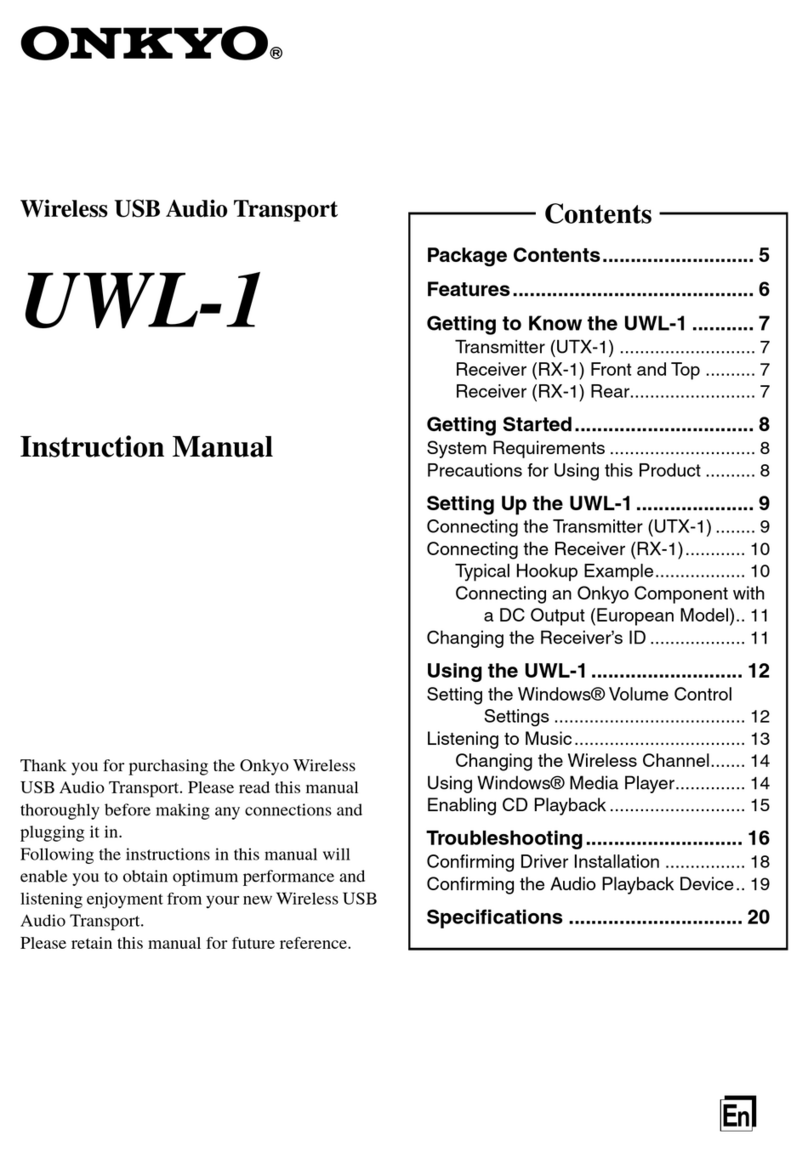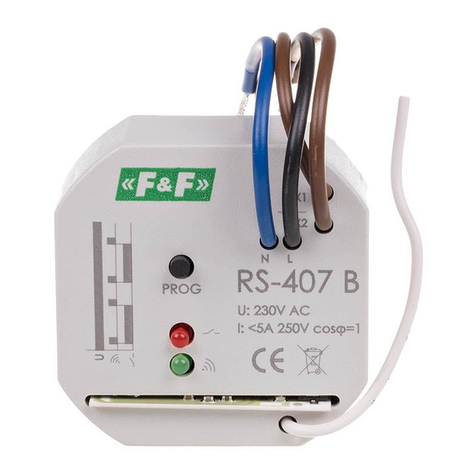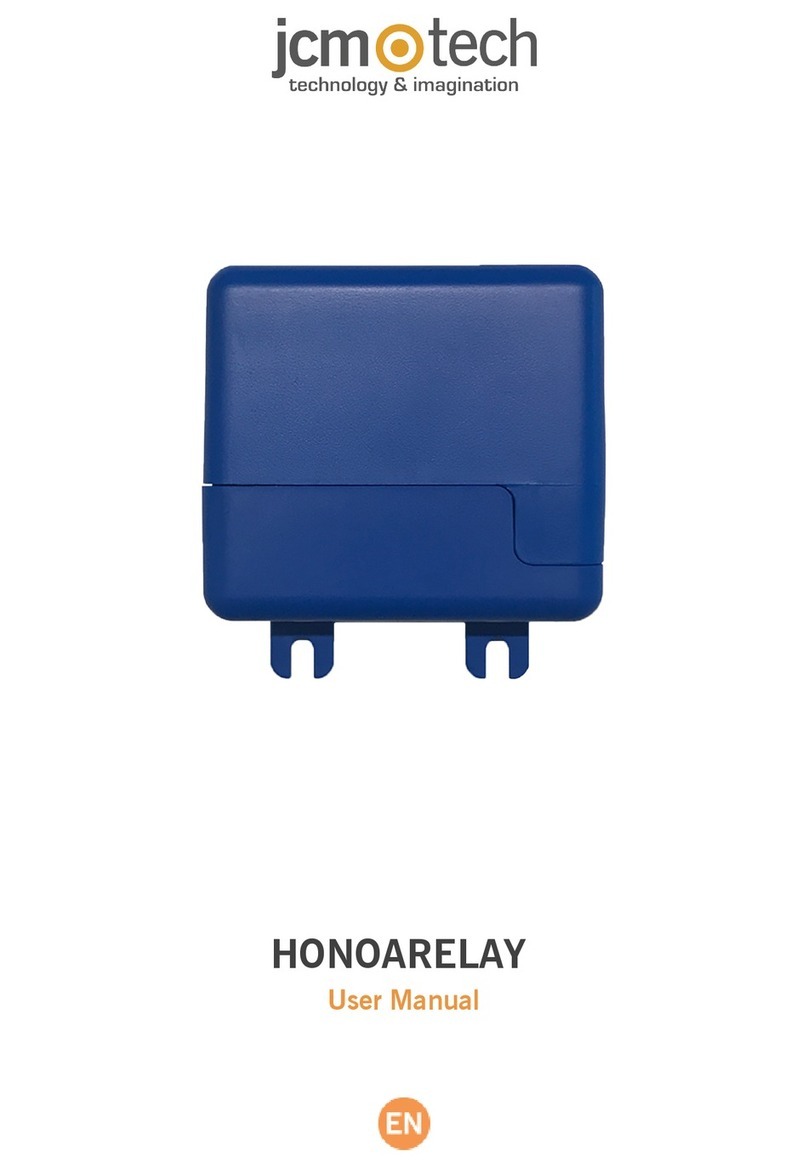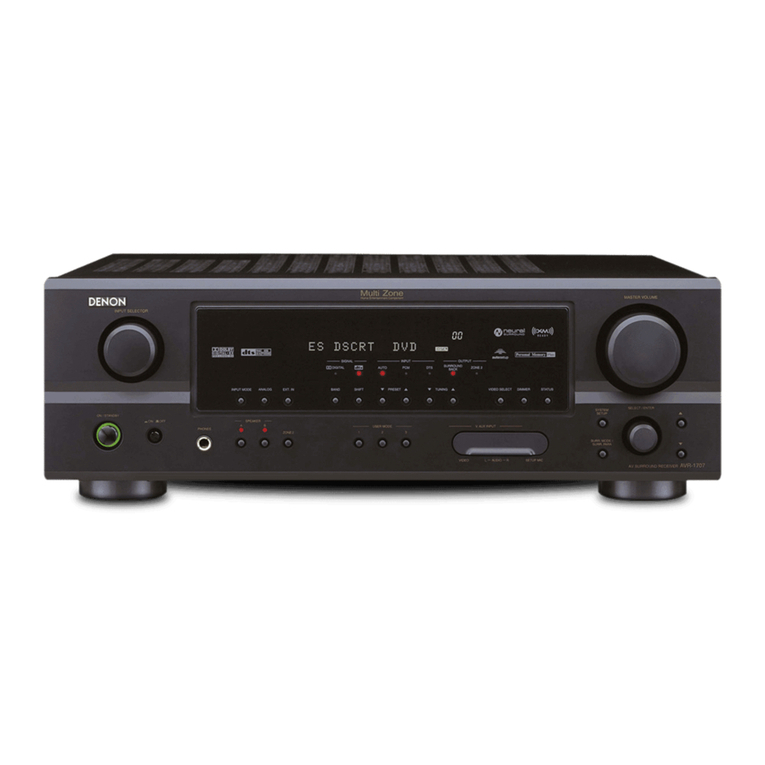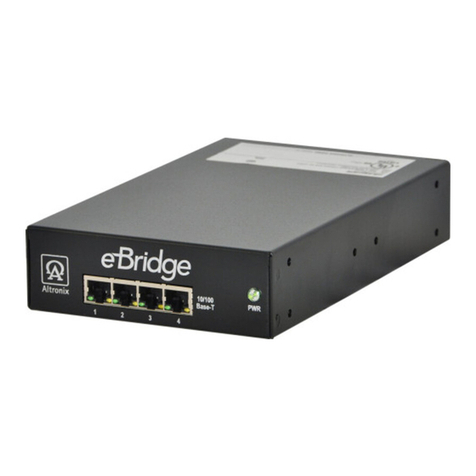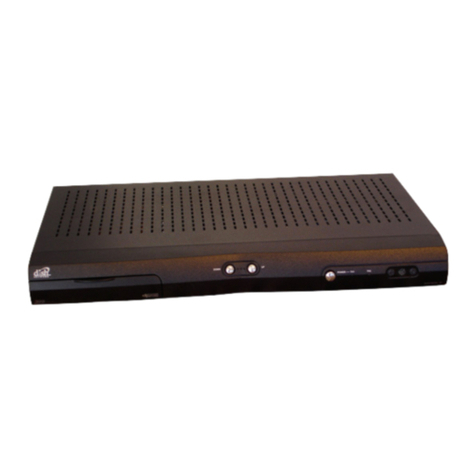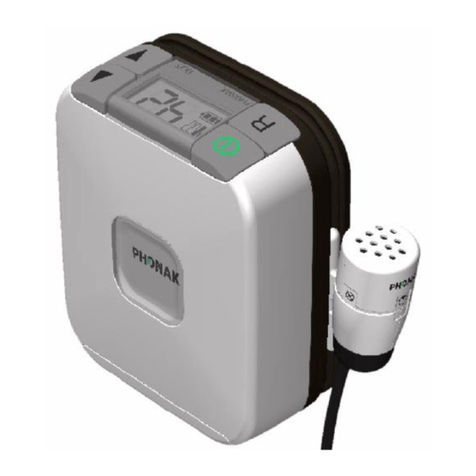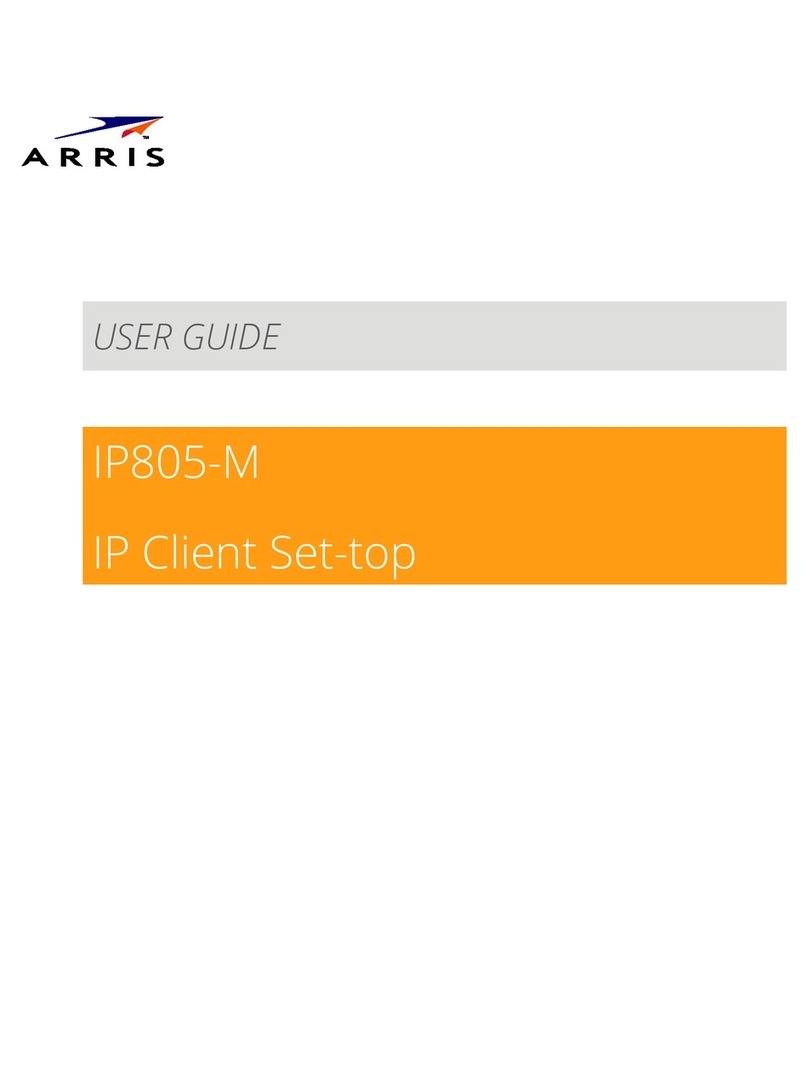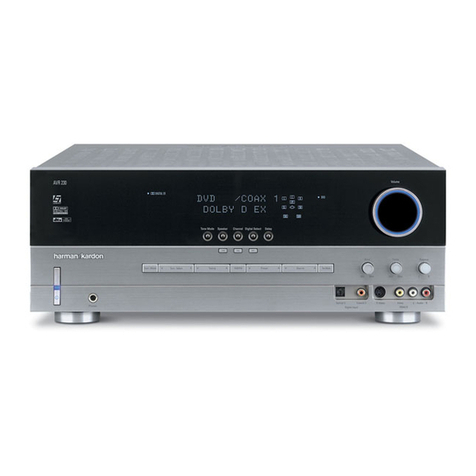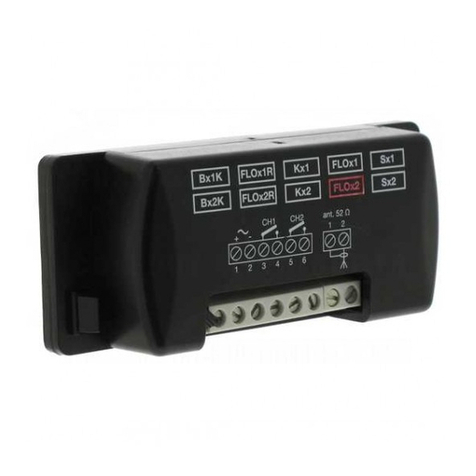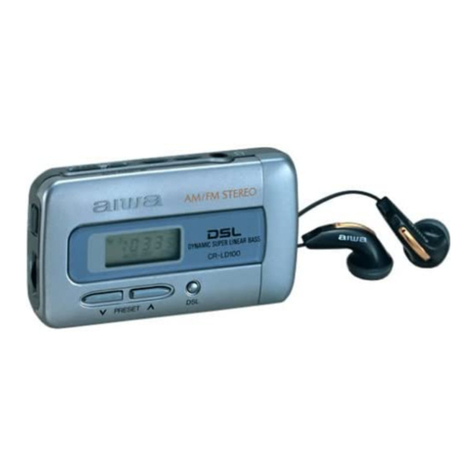Icom IC-R30 Installation guide

BASIC MANUAL
COMMUNICATIONS RECEIVER
iR30
This device complies with Part 15 of the FCC
rules. Operation is subject to the following two
conditions: (1) This device may not cause harmful
interference, and (2) this device must accept any
interference received, including interference that
may cause undesired operation.
WARNING: MODIFICATION OF THIS DEVICE
TO RECEIVE CELLULAR RADIOTELEPHONE
SERVICE SIGNALS IS PROHIBITED UNDER
FCC RULES AND FEDERAL LAW.

i
BASIC MANUAL
Thank you for choosing this Icom product.
This product is designed and built with
Icom’s state of the art technology and
craftsmanship. With proper care, this
product should provide you with years of
trouble-free operation.
■Important
READ ALL INSTRUCTIONS carefully
and completely before using the receiver.
SAVE THIS INSTRUCTION
MANUAL — This instruction manual
contains important operating instructions
for the IC-R30.
For advanced features and instructions,
see ADVANCED MANUAL on the Icom
website for details.
■Features
zDualwatch function that can
simultaneously receive and record two
different bands or modes*
* DV/DV, AM/AM, FM-N/FM-N, and DV/
FM-N mode dualwatch is not available.
zCovers 0.100 MHz to 3304.99999 MHz
for wide band reception
zReceives various digital modes such as
D-STAR, APCO P25 (Phase 1), NXDN,
dPMR, and DCR (Digital Convenience
Radio)
zA USB connector for data transmission
or battery charging
zBluetooth®function that can connect to a
Bluetooth®device such as the VS-3
zBuilt-in GPS receiver to check your
current location
zMeets IP57 requirements for dust-
protection and waterproof protection
(When the battery, antenna, jack cap,
and the slot cover are attached)
■Explicit denitions
WORD DEFINITION
RDANGER!
Personal death, serious
injury or an explosion may
occur.
RWARNING!
Personal injury, re hazard or
electric shock may occur.
CAUTION Equipment damage may
occur.
NOTE
If disregarded, inconvenience
only. No risk of personal
injury, re or electric shock.
Icom is not responsible for the
destruction, damage to, or performance
of any Icom or non-Icom equipment, if the
malfunction is because of:
•Force majeure, including, but not
limited to, res, earthquakes, storms,
oods, lightning, other natural disasters,
disturbances, riots, war, or radioactive
contamination.
•The use of Icom receivers with any
equipment that is not manufactured or
approved by Icom.
Icom, Icom Inc. and the Icom logo are
registered trademarks of Icom Incorporated
(Japan) in Japan, the United States, the
United Kingdom, Germany, France, Spain,
Russia, Australia, New Zealand, and/or other
countries.
NXDN is a trademark of Icom Incorporated
and JVC KENWOOD Corporation.
dPMR is a trademarks of the dPMR MoU
Association.
Adobe, Acrobat, and Reader are either
registered trademarks or trademarks of Adobe
Systems Incorporated in the United States
and/or other countries.
Microsoft and Windows are registered
trademarks of Microsoft Corporation in the
United States and/or other countries.
The Bluetooth word mark and logos are
registered trademarks owned by Bluetooth
SIG, Inc. and any use of such marks by Icom
inc. is under license.
Other trademarks and trade names are those
of their respective owners.

ii
1
7
4
10
15
18
2
8
13
5
11
16
3
9
14
6
12
17
BASIC MANUAL
■FCC Information
This equipment has been tested and found
to comply with the limits for a Class B digital
device, pursuant to part 15 of the FCC
Rules. These limits are designed to provide
reasonable protection against harmful
interference in a residential installation. This
equipment generates, uses and can radiate
radio frequency energy and, if not installed
and used in accordance with the instructions,
may cause harmful interference
to radio communications. However, there is no
guarantee that interference will not occur in a
particular installation.
If this equipment does cause harmful
interference to radio or television reception,
which can be determined by turning the
equipment off and on, the user is encouraged
to try to correct the interference by one or
more of the following measures:
•Reorient or relocate the receiving antenna.
•Increase the separation between the
equipment and receiver.
•Connect the equipment into an outlet on
a circuit different from that to which the
receiver is connected.
•Consult the dealer or an experienced radio/
TV technician for help.
CAUTION: Changes or modications
to this device, not expressly approved
by Icom Inc., could void your authority
to operate this device under FCC
regulations.
■IC-R30 and Bluetooth®
Interference
Bluetooth uses the 2.4 GHz band. When
using the IC-R30 in the 2.4 GHz band
near a Bluetooth device, interference
may occur. This may cause a decrease in
communication speed, and an unstable
connection.
In such case, use the IC-R30 away from
the Bluetooth device communication area,
or stop using the Bluetooth device.
■Information FCC
Cet équipement a été testé et reconnu
conforme aux limites xées pour un appareil
numérique de classe B, conformément au
point 15 de la réglementation FCC. Ces
limites ont été xées an d’assurer une
protection raisonnable contre les interférences
nocives dans une installation résidentielle.
Cet équipement génère, utilise et peut
émettre un rayonnement de fréquence radio.
S’il n’a pas été installé conformément aux
instructions, il peut par ailleurs créer des
interférences perturbant les communications
radio. Toutefois, il n’y a aucune garantie que
les interférences ne se produiront pas dans
une installation particulière.
Si cet équipement crée des interférences
perturbant la réception de la radio ou de la
télévision, comme cela peut être déterminé
en éteignant et en allumant l’équipement,
l’utilisateur est invité à essayer de corriger
l’interférence en prenant une ou plusieurs des
mesures ci-après:
•Réorienter ou changer de place l’antenne de
réception.
•Éloi gner l’équipement et le récepteur.
•Connecter l’équipement sur une prise sur un
autre circuit que celui sur lequel le récepteur
est connecté.
•Faire appel au revendeur ou à un technicien
radio/TV expérimenté.
MISE EN GARDE: Tout changement ou
modication, non expressément approuvé
par Icom Inc., peut annuler l'autorisation
de l'utilisateur à utiliser cet appareil
conformément à la réglementation FCC.
■IC-R30 et interférences
Bluetooth
®
Bluetooth utilise la bande de 2,4 GHz. Si
vous utilisez l’IC-R30 dans la bande de 2,4
GHz à proximité d’un appareil Bluetooth,
ceci peut provoquer des interférences. Ceci
peut réduire le débit de communication et
rendre la connexion instable.
Dans ce cas, utilisez l’IC-R30 à distance
sufsante de la zone de communication
de l’appareil Bluetooth ou cessez d’utiliser
l’appareil Bluetooth.

iii
BASIC MANUAL
■Precautions
RDANGER! NEVER operate the receiver
near unshielded electrical blasting caps or in
an explosive atmosphere. This could cause an
explosion and death.
RWARNING! NEVER use or charge Icom
battery packs with non-Icom receivers or non-
Icom chargers. Only Icom battery packs are
tested and approved for use with Icom receivers
or charged with Icom chargers. Using third-party
or counterfeit battery packs or chargers may
cause smoke, re, or cause the battery to burst.
RWARNING! NEVER operate the equipment
with a headset or other audio accessories at
high volume levels. The continuous high volume
operation may cause a ringing in your ears. If you
experience the ringing, reduce the volume level
or discontinue use.
RWARNING! NEVER operate the receiver
while driving a vehicle. Safe driving requires your
full attention— anything less could result in an
accident.
CAUTION: DO NOT short the terminals of the
battery pack. Shorting may occur if the terminals
touch metal objects such as a key, so be careful
when placing the battery packs (or the receiver)
in bags, and so on. Carry them so that shorting
cannot occur with metal objects. Shorting may
damage not only the battery pack, but also the
receiver.
CAUTION: DO NOT connect the receiver directly
to a power source of more than the specied DC
voltage or use reverse polarity. Otherwise this will
damage the receiver.
CAUTION: DO NOT operate the receiver unless
the antenna, battery pack and covers are dry
before and after being securely attached. Conrm
that the antenna and battery pack are dry before
attaching. Exposing the inside to dust or water
can damage the receiver. After exposure to
water, clean the battery contacts thoroughly with
fresh water and dry them completely to remove
any water or salt residue.
CAUTION: DO NOT use harsh solvents such
as Benzine or alcohol when cleaning. This could
damage the equipment surfaces. If the surface
becomes dusty or dirty, wipe it clean with a soft,
dry cloth.
CAUTION: DO NOT place or leave the receiver
in direct sunlight or in areas with temperatures
below –20°C (–4˚F) or above +60°C (+140˚F).
BE CAREFUL! The receiver meets IP57*
requirements for dust-protection and waterproof
protection. However, once the receiver has
been dropped, waterproof protection cannot be
guaranteed because of possible damage to the
receiver’s case or the waterproof seal.
* Only when the BP-287 and antenna are
attached and [SP/USB] cover and [microSD]
slot cover are closed.
NOTE: Even when the receiver power is OFF, a
slight current still ows in the circuits. Remove
the battery pack or batteries from the receiver
when not using it for a long time. Otherwise, the
installed battery pack or batteries will become
exhausted, and will need to be recharged or
replaced.

iv
1
7
4
10
15
18
2
8
13
5
11
16
3
9
14
6
12
17
BASIC MANUAL
■Précautions
RDANGER! N’utilisez JAMAIS le récepteur à
proximité de détonateurs électriques non blindés
ou dans une atmosphère explosive. Cela pourrait
causer une explosion mortelle.
RAVERTISSEMENT! N’utilisez JAMAIS et ne
rechargez JAMAIS des blocs-batteries Icom avec
des récepteurs non-Icom ou des chargeurs non-
Icom. Seuls les blocs-batteries Icom sont testés et
homologués pour une utilisation avec les récepteurs
Icom ou être chargés avec les chargeurs Icom.
L’utilisation de blocs-batteries ou de chargeurs tiers
ou de contrefaçon peut être à l’origine de fumées,
d’incendie ou peut faire éclater la batterie.
RAVERTISSEMENT! N’utilisez JAMAIS
l’équipement avec un casque ou tout autre
accessoire audio à un niveau sonore élevé.
L’utilisation continue à un niveau sonore élevé peut
provoquer un bourdonnement dans vos oreilles. Si
vous entendez un bourdonnement baissez le niveau
du volume ou interrompez l’utilisation.
RAVERTISSEMENT! N’utilisez JAMAIS le
récepteur en conduisant un véhicule. La sécurité de
la conduite requiert toute l’attention du conducteur —
toute défaillance peut être à l’origine d’un accident.
ATTENTION: NE PAS court-circuiter les bornes du
bloc-batterie. Un court-circuit peut se produire si les
bornes touchent des objets métalliques, tels que des
clés, faites donc attention lorsque vous rangez les
blocs-batteries (ou le récepteur) dans des sacs, etc.
Transportez-les de telle sorte que des courts-circuits
ne peuvent se produire avec des objets métalliques.
Car cela peut endommager le bloc-batterie ainsi que
le récepteur.
ATTENTION: NE PAS NE branchez PAS
directement le récepteur à une source d’alimentation
de tension CC supérieure à celle spéciée, ou
N’inversez PAS la polarité. Cela endommagerait le
récepteur.
ATTENTION: NE PAS N’utilisez PAS le récepteur
à moins que l’antenne, le bloc-batterie et les
couvercles soient secs avant et après leur mise
en place. Vériez que l’antenne et le bloc-batterie
sont secs avant de les xer. Exposer l’intérieur
à la poussière ou à l’eau peut endommager le
récepteur. Après tout contact avec de l’eau, nettoyez
soigneusement les contacts de la batterie à l’eau
courante et séchez-les complètement an d’éliminer
l’eau ou les dépôts de sel.
ATTENTION: N’utilisez PAS de solvants agressifs
tels que du benzène ou de l’alcool lors du nettoyage.
Cela risque d’endommager les surfaces de
l’équipement. Si la surface est poussiéreuse ou sale,
nettoyez-la avec un tissu doux et sec.
ATTENTION: NE PAS placer ou laisser le récepteur
en plein soleil ou dans des zones dans lesquelles
les températures sont inférieures à –20 °C (–4 ˚F) ou
supérieures à +60 °C (+140 ˚F).
MISE EN GARDE! Le récepteur répond aux
exigences de la norme IP57* en matière de
protection contre la poussière et d’étanchéité.
Toutefois, lorsque le récepteur est tombé,
l’étanchéité ne peut pas être garantie, en raison des
risques de dommages affectant le boîtier ou le joint
d’étanchéité du récepteur.
* Uniquement lorsque le BP-287 et l’antenne sont
connectés et que le couvercle de la [SP/USB] et de
la [microSD] sont fermés.
REMARQUE: Même lorsque le récepteur est hors
tension, un léger courant circule encore dans les
circuits. Retirez le bloc-batterie ou les batteries du
récepteur lorsque vous ne l’utilisez pas pendant
une longue période. Dans le cas contraire, le bloc-
batterie ou les batteries installées se déchargent, et
auront besoin d’être rechargées ou remplacées.

v
BASIC MANUAL
DBattery cautions
Misuse of Li-ion batteries may result in the
following hazards: smoke, re, or the battery
may rupture. Misuse can also cause damage
to the battery or degradation of battery’s
performance.
RDANGER! NEVER strike or otherwise impact
the battery pack. Do not use the battery pack if it
has been severely impacted or dropped, or if the
pack has been subjected to heavy pressure. Battery
pack damage may not be visible on the outside of
the case. Even if the surface of the battery does not
show cracks or any other damage, the cells inside
the battery may rupture or catch re.
RDANGER!
NEVER place or leave the battery
pack in areas with temperatures above 60˚C (140˚F).
High temperature buildup in the battery cells, such as
could occur near res or stoves, inside a sun-heated
vehicle, or in direct sunlight for long periods of time
may cause the battery cells to rupture or catch re.
Excessive temperatures may also degrade pack’s
performance or shorten the battery cell’s life.
RDANGER! NEVER place or leave battery
packs near re. Fire or heat may cause them
to rupture or explode. Dispose of used battery
packs in accordance with local regulations.
RDANGER! NEVER solder the battery
terminals, or NEVER modify the battery pack.
This may cause heat generation, and the battery
may burst, emit smoke or catch re.
RDANGER! NEVER let uid from inside
the battery get in your eyes. This can cause
blindness. Rinse your eyes with clean water,
without rubbing them, and immediately get
medical treatment from an eye doctor. NEVER
disassemble the battery pack.
RWARNING! NEVER use the battery if it emits
an abnormal odor, heats up, or is discolored
or deformed. If any of these conditions occur,
contact your Icom dealer or distributor.
RWARNING! NEVER let uid from inside the
battery cells come in contact with your body. If it
does, immediately wash with clean water.
RWARNING! NEVER
put the battery pack in a
microwave oven, high-pressure container, or in an
induction heating cooker. This could cause a re,
overheating, or cause the battery cells to rupture.
RCAUTION: DO NOT expose the battery pack
to rain, snow, saltwater, or any other liquids. Do not
charge or use a wet pack. If the pack gets wet, be
sure to wipe it dry before using.
CAUTION: DO NOT use the battery pack outside
the specied temperature range, –20˚C ~ +60˚C
(–4˚F ~ +140˚F). Otherwise this will reduce the
pack’s performance and battery cell life.
DO NOT leave the pack fully charged, completely
discharged, or in an excessive temperature
environment (above 50˚C, 122˚F) for an
extended period of time. Otherwise a shorter
battery pack life could occur. If the battery pack
must be left unused for a long time, it must be
detached from the receiver after discharging. You
may use the pack until the remaining capacity is
about half, then keep it safely in a cool dry place
in the following temperature range:
–20˚C (–4˚F) ~ +50˚C (+122˚F) (for a month)
–20˚C (–4˚F) ~ +40˚C (+104˚F)
(for three months)
–20˚C (–4˚F) ~ +20˚C (+68˚F) (for a year).
NOTE: Replace the battery pack with a new one
approximately ve years after manufacturing,
even if it still holds a charge. The material inside
the battery material will become weak after a
period of time, even with little use. The estimated
number of times you can charge the pack is
between 300 and 500. Even when the battery
appears to be fully charged, the operating time of
the receiver may become short when:
• Approximately ve years have passed since the
battery was manufactured.
• The pack has been repeatedly charged.
DCharging cautions
RDANGER! NEVER charge the battery pack in
areas with extremely high temperatures, such as
near res or stoves, inside a sun-heated vehicle,
or in direct sunlight. Otherwise the safety/
protection circuit in the battery will activate,
causing the battery cells to stop charging.
RDANGER! NEVER charge the receiver during
a lightning storm. It may result in an electric shock,
cause a re or damage the receiver. Always
disconnect the power adapter before a storm.
RWARNING! DO NOT charge or leave
the battery in the battery charger beyond the
specied time for charging. If the pack is not
completely charged by the specied time, stop
charging and remove the battery from the
battery charger. Continuing to charge the battery
beyond the specied time limit may cause a re,
overheating, or the battery may rupture.
RCAUTION: DO NOT
insert the receiver with the
battery pack attached into the charger if they are wet or
soiled. This could corrode the battery charger terminals
or damage the charger. The charger is not waterproof.
CAUTION: DO NOT charge the battery pack
outside of the specied temperature range:
15˚C ~ 40˚C (59˚F ~ 104˚F). Icom recommends
charging the pack at 25˚C (77˚F). The pack
may heat up or rupture if charged out of the
specied temperature range. Additionally, battery
performance or battery life may be reduced.
■Battery and charging cautions

vi
1
7
4
10
15
18
2
8
13
5
11
16
3
9
14
6
12
17
BASIC MANUAL
■Charge de la batterie
DMise en garde concernant la
batterie
Une mauvaise utilisation des batteries au Li-ion
présente les risques suivants : dégagement de fumée,
incendie ou éclatement de la batterie.
Une mauvaise utilisation peut également endommager
la batterie ou en dégraderses performances.
RDANGER! NE JAMAIS cogner ou provoquer d’autres
chocs sur le bloc-batterie. Ne pas utiliser un bloc-batterie
qui a reçu un choc important, qui est tombé au sol ou
qui a été soumis à de fortes pressions. Les dommages
subis par un bloc-batterie peuvent ne pas être visibles de
l’extérieur. Même si la surface de la batterie ne semble
pas ssurée ou endommagée, les cellules à l’intérieur de
la batterie peuvent se rompre ou prendre feu.
RDANGER! NE JAMAIS placer ou laisser le bloc-
batterie dans des lieux dans lesquels les températures
sont supérieures à +60 °C (+140 °F).
La montée en température de la batterie, comme cela
peut survenir à proximité de ammes ou de poêles, à
l’intérieur d’un véhicule exposé au soleil, ou en plein
soleil pendant une période prolongée peut causer
une rupture des cellules ou enammer la batterie. Les
températures excessives peuvent également dégrader
les performances du bloc ou réduire la durée de vie des
cellules de la batterie.
RDANGER! NE JAMAIS placer ou laisser des
blocs-batteries près du feu. La chaleur ou des
ammes peuvent provoquer un éclatement ou une
explosion. Mettez au rebut les blocs-batteries usagés
conformément à la réglementation locale.
RDANGER! NE JAMAIS souder les bornes de la
batterie ou bien NE JAMAIS modier le blocbatterie. Ceci
peut provoquer une surchauffe de la batterie, qui risque
alors d’éclater, de fumer ou de prendre feu.
RDANGER! NE JAMAIS laisser du liquide provenant
de l’intérieur de la batterie entrer en contact avec
vos yeux. Cela peut causer une cécité. Rincez-vous
abondamment les yeux à l’eau courante, sans les
frotter et consultez immédiatement un médecin pour un
traitement médical. NE JAMAIS ouvrir la batterie.
RAVERTISSEMENT!
NE JAMAIS utiliser la batterie si
elle dégage une odeur anormale, si elle surchauffe, si elle
est décolorée ou déformée. Si l’une de ces situations se
produit, contactez votre revendeur ou distributeur Icom.
RAVERTISSEMENT! NE JAMAIS laisser du liquide
provenant de l’intérieur des cellules de la batterie entrer
en contact avec votre corps. Si cela se produit, rincez
abondamment avec de l’eau propre.
RAVERTISSEMENT! NE JAMAIS
mettre le bloc-batterie
dans un four à micro-ondes, un récipient haute-pression
ou dans un appareil de cuisson à induction. Ceci peut
provoquer un incendie, une surchauffe ou conduire à la
rupture des cellules de la batterie.
AMISE EN GARDE:
NE PAS exposer le blocbatterie à
la pluie, à la neige, à l’eau salée, ou à tout autre liquide.
Ne pas charger ou utiliser un bloc humide. Si un bloc est
humide, veillez à l’essuyer complètement avant de l’utiliser.
ATTENTION: NE PAS utiliser le bloc-batterie hors de la
plage de température spéciée, –20 ˚C ~ +60 °C (–4 °F
à +140 °F). Cela réduirait la performance du bloc et la
durée de vie des cellules de la batterie.
ATTENTION: NE PAS laisser le bloc à pleine charge,
entièrement déchargé, ou dans un environnement à
température excessive (supérieure à 50 °C, 122 ˚F)
pendant une période prolongée. Dans le cas contraire,
la durée de vie du bloc-batterie peut être réduite. Si vous
prévoyez de ne pas utiliser le bloc-batterie pendant une
période prolongée, retirez-le du récepteur après qu’il soit
déchargé. Vous pouvez utiliser le bloc jusqu’à ce que la
capacité soit environ réduite de moitié, puis le conserver
en sécurité dans un endroit frais et sec dans la plage de
température suivante :
–20 °C (–4 °F) ~ +50 ˚C (122 ˚F) (pendant un mois)
–20 ˚C (–4 °F) ~ +40 °C (+104 °F)
(pendant trois mois)
–20 ˚C (-4 °F) ~ +20 ˚C (+68 °F) (pendant un an).
REMARQUE: Remplacez le bloc-batterie par un neuf
environ cinq ans après sa fabrication, même s’il conserve
une charge. Les matériaux présents à l’intérieur du
matériau de la batterie se détériorent après un certain
temps, même en cas d’utilisation réduite. L’estimation
du nombre de fois que vous pouvez recharger le
bloc est comprise entre 300 et 500. Même lorsque la
batterie semble chargée complètement, le temps de
fonctionnement du récepteur peut être réduit si :
• Environ cinq ans se sont écoulé depuis que la batterie
à été fabriquée.
• Le bloc a été chargé de nombreuses fois.
DMises en garde concernant
la charge
RDANGER! NE JAMAIS charger le bloc-batterie à
des endroits exposés à des températures extrêmement
élevées, comme à proximité de ammes ou de
poêles, à l’intérieur d’un véhicule exposé au soleil,
ou en plein soleil. Dans le cas contraire, le circuit de
sécurité/protection à l’intérieur de la batterie s’activera,
provoquant l’arrêt de la charge.
RDANGER! NE JAMAIS charger le récepteur durant un
orage. Cela risquerait de provoquer un choc électrique,
un incendie ou d’endommager le récepteur. Toujours
débrancher l’adaptateur d’alimentation avant une tempête.
RAVERTISSEMENT!
NE JAMAIS recharger ou laisser la
batterie dans le chargeur de batterie au-delà du temps spécié
pour la charge. Si le bloc n’est pas complètement chargé
après le temps spécié, interrompez la recharge et retirez la
batterie du chargeur de batterie. En continuant à charger la
batterie au-delà du temps spécié, vous pouvez provoquer un
incendie, une surchauffe ou détériorer la batterie.
RAVERTISSEMENT! NE PAS insérer le récepteur avec
le bloc-batterie xé dans le chargeur s’ils sont humides
ou sales. Ceci peut corroder les bornes du chargeur de
la batterie ou endommager le chargeur. Le chargeur
n’est pas étanche.
ATTENTION: NE PAS charger le bloc-batterie hors de
la plage de température spéciée : 15 ˚C ~ 40 °C (59 °F
~ 104 °F). Icom recommande de charger la batterie à 25
°C (77 °F). Le bloc peut surchauffer ou être détérioré s’il
est chargé hors de la plage de température spéciée.
Par ailleurs, ceci peut réduire les performances ou la
longévité de la batterie.

vii
BASIC MANUAL
■Recommendation
CLEAN THE RECEIVER THOROUGHLY
IN A BOWL OF FRESH WATER after
exposure to saltwater, and dry it before
operating. Otherwise, the receiver’s keys,
switches, and controllers may become
unusable, due to salt crystallization, and/or
the charging terminals of the battery pack
may corrode.
NOTE: If the receiver’s waterproof
protection appears defective, carefully
clean it with a soft, damp (fresh water)
cloth, then dry it before operating.
The receiver may lose its waterproof
protection if the case, jack cap, or
connector cover is cracked or broken, or
the receiver has been dropped.
Contact your Icom distributor or your
dealer for advice.
■Operating theory
Electromagnetic radiation, which has
frequencies of 20,000 Hz (20 kHz*) and
above, is called radio frequency (RF)
energy because, it is useful in radio
transmissions. The IC-R30 receives RF
energy from 0.100 MHz* to 3304.99999
MHz and converts it into audio frequency
(AF) energy which in turn actuates a
loudspeaker to create sound waves.
AF energy is in the range of 20 to 20,000 Hz.
* kHz is an abbreviation of kilohertz or 1000
hertz, MHz is abbreviation of megahertz
or 1,000,000 hertz, where hertz is a unit
of frequency.
■Operating notes
The IC-R30 may receive its own oscillated
frequency, resulting in no reception or only
noise reception, on some frequencies.
The IC-R30 may receive interference
from extremely strong signals on different
frequencies or when using an external
high-gain antenna.

viii
1
7
4
10
15
18
2
8
13
5
11
16
3
9
14
6
12
17
BASIC MANUAL
■About CE and DOC
Hereby, Icom Inc. declares
that the versions of IC-R30
which have the “CE” symbol
on the product, comply with
the essential requirements of the Radio
Equipment Directive, 2014/53/EU, and the
restriction of the use of certain hazardous
substances in electrical and electronic
equipment Directive, 2011/65/EU. The full
text of the EU declaration of conformity is
available at the following internet address:
http://www.icom.co.jp/world/support
■Disposal
The crossed-out wheeled-bin
symbol on your product,
literature, or packaging
reminds you that in the
European Union, all electrical
and electronic products,
batteries, and accumulators
(rechargeable batteries) must be taken to
designated collection locations at the end
of their working life. Do not dispose of
these products as unsorted municipal
waste. Dispose of them according to the
laws in your area.
■Voice coding technology
The AMBE+2™ voice coding Technology
embodied in this product is protected
by intellectual property rights including
patent rights, copyrights and trade secrets
of Digital Voice Systems, Inc. This voice
coding Technology is licensed solely for
use within this Communications Equipment.
The user of this Technology is explicitly
prohibited from attempting to extract,
remove, decompile, reverse engineer, or
disassemble the Object Code, or in any
other way convert the Object Code into a
human-readable form. U.S. Patent Nos.
#8,595,002, #8,359,197, #8,315,860,
#8,200,497, #7,970,606 and #6,912,495 B2.

ix
BASIC MANUAL
■Important notes
DWhen using the GPS receiver
•The GPS receiver is installed under the receiver’s top panel. Therefore, when the GPS
receiver is activated, do not cover the top with anything that will block the satellite
signals.
The GPS receiver is installed here.
•GPS signals cannot pass through metal objects. When using the receiver inside a
vehicle, you may not receive GPS signals. We recommend you use it near a window.
•The GPS receiver may not work if used in the following locations:
1. Tunnels or high-rise buildings
2. Underground parking lots
3. Under a bridge or viaduct
4. In remote forested areas
5. Under bad weather conditions (rainy or cloudy day)
•The Global Positioning System (GPS) is built and operated by the U.S. Department of
Defense. The Department is responsible for accuracy and maintenance of the system.
Any changes by the Department may affect the accuracy and function of the GPS
system.
DSpurious signals
You may hear some noises caused by spurious signals generated in the receiver’s circuit
but they do not indicate a receiver malfunction.
DNoise signals while charging
You may hear some noises caused by signals generated in the charging circuit. Be sure
to turn OFF the receiver before charging.

x
1
7
4
10
15
18
2
8
13
5
11
16
3
9
14
6
12
17
BASIC MANUAL
■About the IC-R30 manuals
The following manuals are supplied for your IC-R30.
DBasic manual (This manual)
Instructions for the basic operations, precautions.
DAdvanced manual (PDF on the Icom website)
Instructions for the advanced operations, as shown below.
•Battery operation*
•Using a microSD card*
•Recording the received audio*
•Memory operation*
•GPS operation*
•Menu screen*
•Other functions*
•Bluetooth®operation*
•Firmware updating
•Options*
• Specications
LThis manual can be downloaded from the Icom website.
*Only the basic instructions are described in this manual.
TIP:
You can download each manual from the Icom website:
http://www.icom.co.jp/world/support
To read the manual, Adobe®Acrobat®Reader®is required. If you have not installed it,
download and install Adobe®Acrobat®Reader®from Adobe Systems Incorporated’s
website.
■Supplied Accessories
Rapid charger
Antenna
Hand strap
Belt clip
Battery pack Power adapter
NOTE: Some accessories are not
supplied, or the shape is different,
depending on the receiver version.
USB cable
(A-microB type)

xi
BASIC MANUAL
TABLE OF CONTENTS
■Important........................................... i
■Features............................................ i
■Explicit denitions ............................. i
■FCC Information................................ii
■IC-R30 and Bluetooth®Interference..ii
■Information FCC................................ii
■IC-R30 et interférences Bluetooth®...ii
■Precautions......................................iii
■Précautions......................................iv
DBattery cautions............................ v
DCharging cautions ........................ v
■Battery and charging cautions ......... v
■Charge de la batterie .......................vi
DMise en garde concernant la
batterie .........................................vi
DMises en garde concernant la
charge ..........................................vi
■Recommendation............................vii
■Operating theory .............................vii
■Operating notes ..............................vii
■Voice coding technology ................viii
■About CE and DOC........................viii
■Disposal .........................................viii
■Important notes................................ix
DWhen using the GPS receiver......ix
DSpurious signals...........................ix
DNoise signals while charging........ix
■About the IC-R30 manuals............... x
DBasic manual (This manual)......... x
DAdvanced manual
(PDF on the Icom website)........... x
■Supplied Accessories....................... x
1 PREPARATION .................................... 1
■Attaching the supplied accessories.. 1
DBattery pack ................................. 1
DAntenna........................................ 1
DHand strap.................................... 1
DBelt clip......................................... 1
■Charging the battery pack................ 2
■Charging time and the capacity of the
battery pack ..................................... 2
■Charging with a USB cable.............. 3
■Inserting a microSD card ................. 4
■Turning ON the receiver................... 4
■Adjusting an audio level................... 4
■S
aving a setting data onto a microSD card
... 5
DFormatting the microSD card ....... 5
DSaving a setting data.................... 6
2 PANEL DESCRIPTION......................... 7
■Front, top, and side panels .............. 7
■Keypad............................................. 8
■Function display............................... 9
3 BASIC OPERATION........................... 11
■MENU screen................................. 11
DMENU screen operation............. 11
DSelecting a Menu item................ 12
■Quick Menu window....................... 13
■Setting the squelch level................ 14
■Monitor function ............................. 14
■Speech function ............................. 14
■Setting the frequency..................... 15
DDirectly entering a frequency...... 15
DChanging the frequency in MHz
steps........................................... 15
DSelecting the tuning step............ 16
■Selecting the Frequency Selecting
mode.............................................. 16
DVariable Frequency Oscillator
(VFO) mode................................ 16
DMemory mode ............................ 16
■Selecting the receive mode............ 17
■Selecting the receive band............. 17
■DIAL/VOL Switch function.............. 18
■Setting the RF gain ........................ 18
■Attenuator ...................................... 18
■Dualwatch function......................... 19
DTurning Dualwatch function ON or
OFF ............................................ 19
DSelecting the MAIN band............ 20
DSetting the volume for
Dualwatch................................... 20
■Key Lock function........................... 20
■Band Scope function...................... 21
DSweep operation ........................ 22
4 RECORDING AND PLAYING BACK . 23
■About the microSD card................. 23
■Setting the Record operation ......... 24
■Recording....................................... 24
DStarting recording....................... 24
DStopping recording ..................... 24
■Playing back................................... 25
■Removing the MicroSD card.......... 26
DRemoving when the receiver is
OFF ............................................ 26
DR
emoving when the receiver is ON
.. 26

xii
1
7
4
10
15
18
2
8
13
5
11
16
3
9
14
6
12
17
BASIC MANUAL
TABLE OF CONTENTS
5 MEMORY CHANNELS ....................... 27
■Selecting a memory channel.......... 27
■Viewing the memory channel
contents ......................................... 27
■Writing a new memory channel...... 28
DWriting to a blank channel.......... 28
DWriting to a specied channel in a
specied group........................... 28
6 SCANNING......................................... 29
■Scan type....................................... 29
DVFO scan ................................... 29
DMemory scan.............................. 29
DTone scan................................... 29
DDuplex scan................................ 29
■About Scans................................... 30
■Starting or canceling the scan........ 31
■Convenient function for a Scan...... 31
■VFO scan....................................... 32
DFull scan (ALL) ........................... 32
DBand scan (BAND)..................... 32
DProgram scan (P00 ~ P49)......... 32
DProgram Link scan
(P-LINK 0 ~ 9) ............................ 32
DAuto memory write scan
(Auto MW) .................................. 32
DEntering Program Scan ranges.. 33
DAbout the Program Link Scan .... 34
DS
etting the Program Link function
... 34
DStoring Skip frequencies ............ 35
DProgram Skip Scan function....... 35
DTemporary Skip function............. 35
■Memory scan ................................. 36
DAll scan (ALL)............................. 36
DMode scan (MODE).................... 36
DNear Station scan
(Near Station)............................. 36
DGroup Link scan
(GROUP LINK)........................... 36
DGroup scan (GROUP 00 ~ 99) ... 36
■DUP Frequency Check function..... 36
DSetting the Group Link................ 37
DSetting the skip channel ............. 37
■About the Priority Watch function... 38
■Starting or canceling the Priority
Watch function ............................... 39
DStarting the Priority Watch.......... 39
DCanceling the Priority Watch...... 39
DT
he Priority Watch and Scanning
.. 39
7 GPS Operation .................................. 40
DChecking the GPS signal ........... 40
■Checking your GPS location.......... 41
DDisplaying Position Data ............ 41
DA
bout the GPS POSITION screen
.. 41
■GPS Logger function...................... 42
DAbout the log le......................... 42
DTurning OFF the GPS Logger
function....................................... 42
8 OTHER FUNCTIONS ......................... 43
■Operating Bluetooth®..................... 43
DElectromagnetic Interference ..... 43
DPairing with a device
(Bluetooth headset).................... 43
DDisconnecting a paired device ... 44
DUnpairing a device...................... 45
■Using the Noise Blanker (NB) ....... 45
■Using the Automatic Noise Limiter
(ANL).............................................. 45
■Using the Automatic Frequency
Control (AFC)................................. 45
■Using the Voice Squelch Control
(VSC) ............................................. 45
■Using a Weather channel
(For only the USA version)............. 46
DSelecting a Weather channel ..... 46
DReceiving a Weather Alert.......... 46
9 RESET/TROUBLESHOOTING .......... 47
■Resetting........................................ 47
DPartial reset ................................ 47
■Troubleshooting ............................. 48
10 Specications.................................... 49
DGeneral....................................... 49
DReceiver ..................................... 49

201802
1
BASIC MANUAL
1PREPARATION
■Attaching the supplied accessories
DBattery pack
Attach (q → w) or detach the battery pack or battery case.
LTurn OFF the receiver before attaching or detaching the
battery pack.
NOTE:
•BE CAREFUL! Do not break your nger nail.
• Even when the receiver is OFF, a small current still
ows in the receiver. Remove the battery pack or case
from the receiver when not using it for a long time.
Otherwise, the batteries in the pack or the case will
become exhausted.
1
2
Battery pack
(Supplied)
Latch
DAntenna
Connect the supplied antenna to the connector.
This receiver has an SMA type antenna connector.
Antenna (Supplied)
Hold here to
tighten the
antenna screw.
DHand strap
RWARNING! NEVER swing the receiver by holding the
hand strap. This can cause injury to yourself or others.
Hand strap
(Supplied)
DBelt clip
To attach the belt clip, slide the belt clip in the direction of
the arrow until the belt clip locks in place, and makes a
‘click’ sound.
To detach the belt clip, lift the tab up (1), and slide the
belt clip in the direction of the arrow (2).
q
w
To detach
Belt clip

2
1
PREPARATION 1
201802 201802
BASIC MANUAL
■Charging the battery pack
Prior to using the receiver for the rst time, the battery pack must be fully charged for
optimum life and operation.
NOTE:
•BE SURE to turn OFF the receiver before charging the battery pack. Otherwise the
attached battery pack cannot be charged completely, or it will take much longer to charge.
• The battery pack becomes hot while charging.
• After the charging is completed, the battery life will be approximately 8.3 hours when the
Dualwatch function is ON (A band: continuously receiving, B band: standing by), the Power
Save function is set to “Auto (Short),” the internal speaker’s volume is set to “20,” the GPS
function is ON, and the Bluetooth function is OFF.
•Depending on your receiving environment, the receiver may be effected by the switching
noise generated from the power adapter. Keep the receiver away from the power adapter.
■Charging time and the capacity of the battery pack
Charging time*: Approximately 4 hours when using the BC-223
* Depending on your receiving situation.
Blink
容量表示
充電表示
Blink
容量表示
充電表示
Blink
容量表示
充電表示
Blinking
The battery
has sufcient
capacity.
The battery is
exhausted a
little.
The battery
is nearing
exhaustion.
The battery
is almost fully
exhausted.
Turn OFF
Receiver +
Battery pack
Self tapping screw M4×35
(User supplied)
Battery pack*
Charge indicator
• Lights orange while
charging.
•Lights green when charging
is completed.
To an AC outlet
Power adapter*
Battery charger*
* May not be supplied, or the shape may be
different, depending on the receiver version.

3
1PREPARATION
201802
BASIC MANUAL
■Charging with a USB cable
You can charge the battery pack with the supplied USB cable (A-microB type).
NOTE:
•BE SURE to turn OFF the receiver before charging the battery pack. Otherwise the
attached battery pack cannot be charged completely, or it will take much longer to charge.
• If you use a third party USB cable, you may not be able to charge:
- Depending on your USB cable or power adapter.
- When using a USB hub or connecting to a low output USB port.
• Charging time is approximately 5 hours when using the supplied USB cable and 1 A output
USB port, and the temperature is 25°C (77°F).
Charging time may differ, depending on the USB port.
USB cable
(A-microB type)
To a USB port PC
Power adapter
or external battery
(User supplied)
Turn OFF

1-1-32 Kamiminami, Hirano-ku,
Osaka 547-0003, Japan
A7447D-1EX-2
Printed in Japan
© 2018 Icom Inc. Sep. 2018
Other manuals for IC-R30
4
Table of contents
Other Icom Receiver manuals
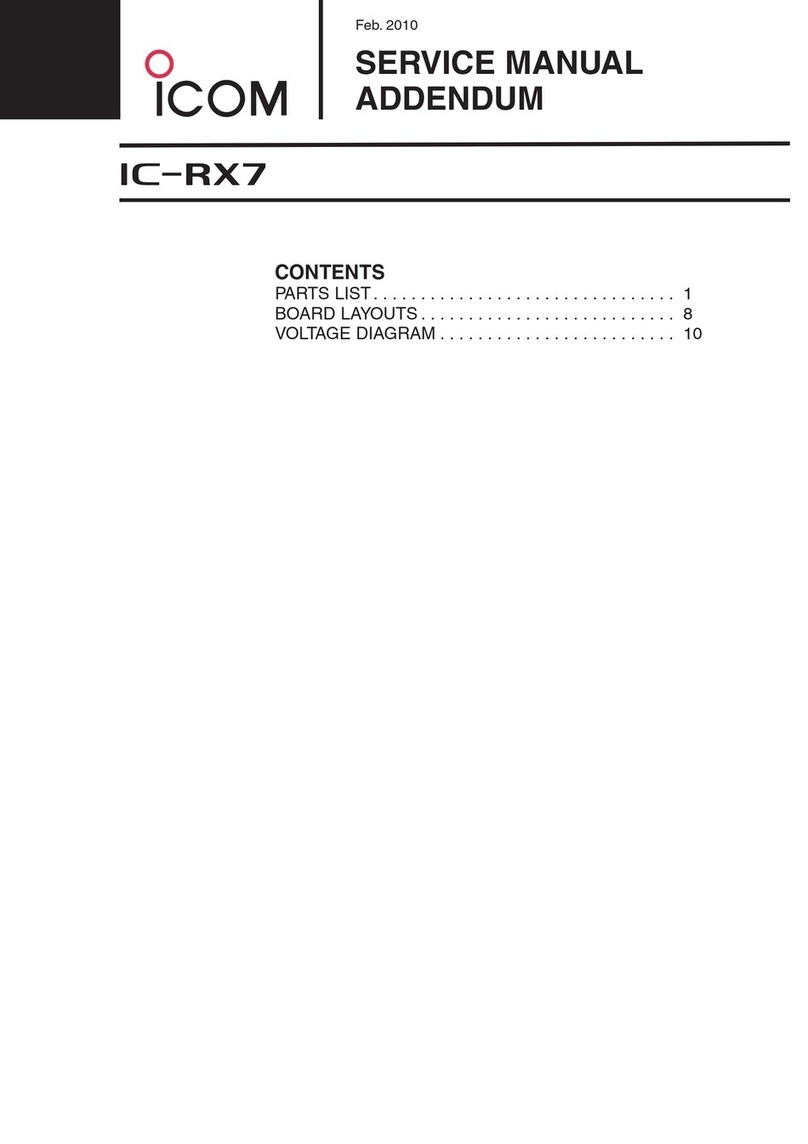
Icom
Icom IC-RX7 Installation and operating instructions
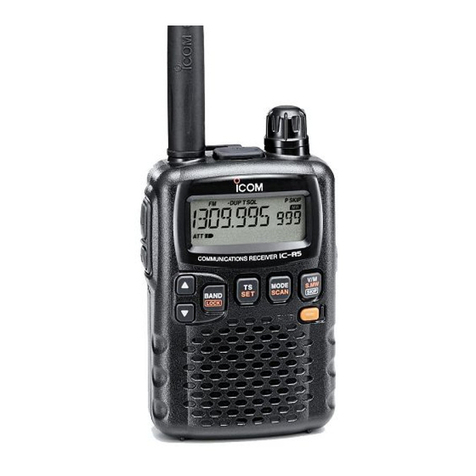
Icom
Icom IC-R5 User manual
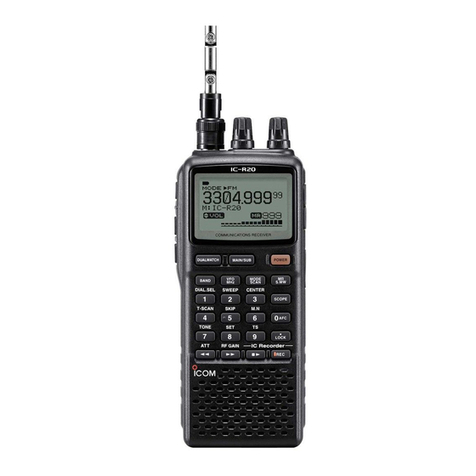
Icom
Icom IC-R20 User manual
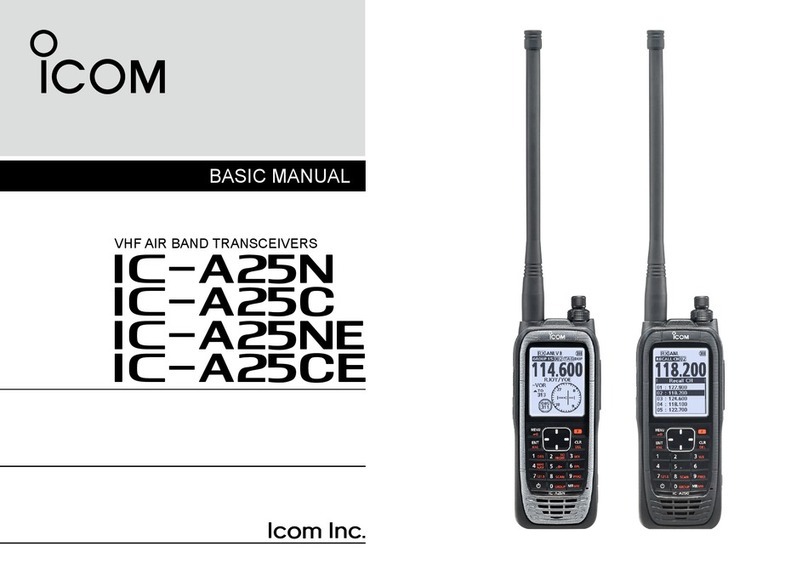
Icom
Icom IC-A25N Installation guide
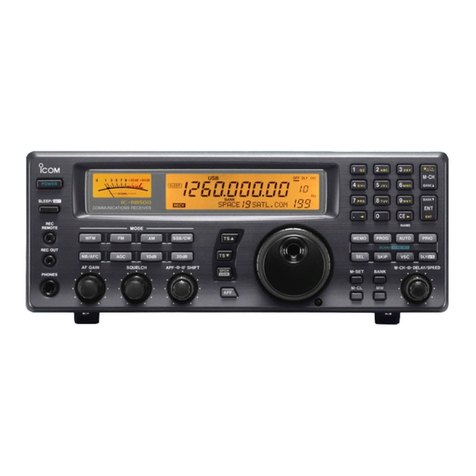
Icom
Icom iC- r8500 Installation and operating instructions

Icom
Icom iR8600 User manual
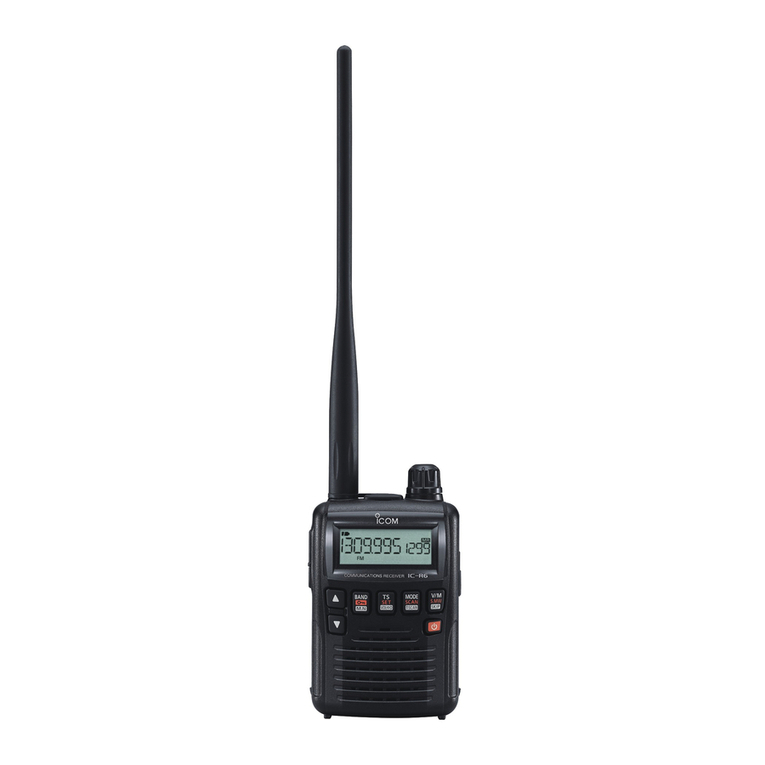
Icom
Icom IC-R6 User manual

Icom
Icom iC- r8500 User manual
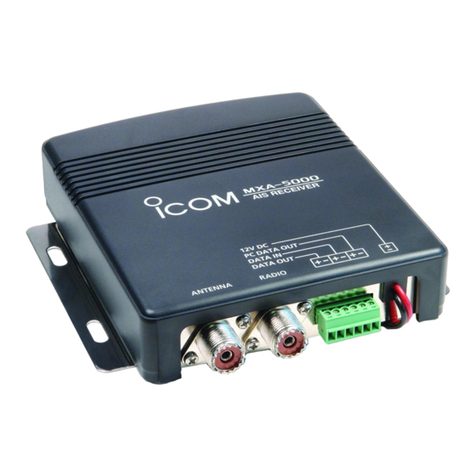
Icom
Icom MXA5000 01 User manual
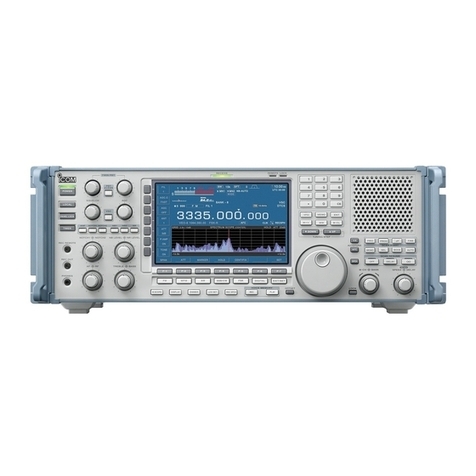
Icom
Icom IC-R9500 User manual

